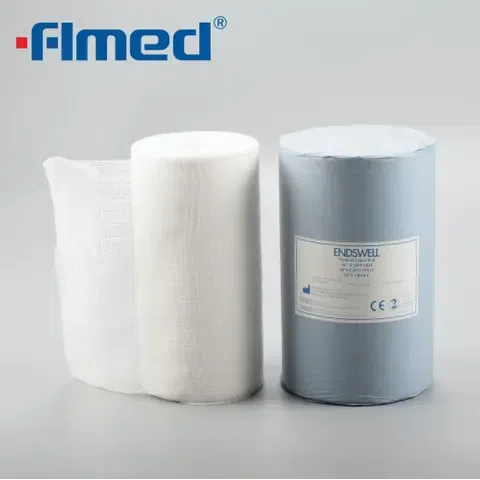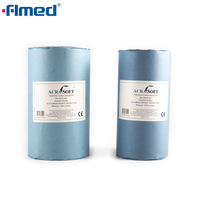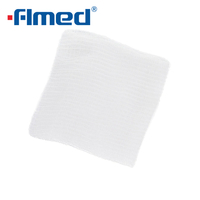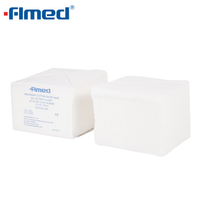
The discussion about sterile versus non-sterile medical gauze is not just theoretical—it directly affects patient outcomes, care routines, and procurement decisions. Many healthcare providers and home-care buyers face the ongoing question: is it always necessary to use sterile gauze, or can non-sterile gauze provide the same benefits in certain situations? At Forlong Medical, where quality medical disposables are our core expertise, we believe the answer depends on wound type, patient risk factors, and the balance between cost and safety. By understanding the contexts in which sterility truly matters, managers and caregivers can create smarter dressing protocols and stock the right mix of products.
What “Sterile” Means for Medical Gauze
Sterility is more than just the absence of visible dirt. For medical gauze, it means the material has undergone a controlled sterilization process that eliminates bacteria, viruses, spores, and other microorganisms. This makes sterile gauze a protective barrier against infection in vulnerable wounds.
Sterilization methods and packaging cues
There are several sterilization methods applied to medical gauze, each ensuring different levels of microbial reduction. Steam sterilization (autoclaving) is widely used for hospital supplies, while gamma radiation and ethylene oxide gas sterilization are common in large-scale gauze manufacturing. These processes are validated under strict international standards to guarantee safety. Packaging also acts as a signal of quality—intact, sealed pouches are the clear sign that the gauze is sterile and safe to apply directly to a wound. If the packaging is damaged or opened, the sterility is compromised and the gauze should not be used for invasive wound care.
Shelf life and storage basics
Every sterile gauze product comes with a printed expiration date. The packaging integrity and storage environment directly affect how long sterility can be maintained. Storing products in a dry, clean, temperature-controlled space prevents moisture or dust from compromising the package. For hospitals and clinics, regular inventory audits ensure that expired sterile gauze is removed before use, avoiding unnecessary risks.
When Sterile Gauze Is Recommended
Certain medical scenarios demand sterile gauze without exception.
Open wounds and post-surgical sites
Deep cuts, surgical incisions, or wounds requiring sutures are at high risk of infection. In these cases, sterile gauze ensures that no external contaminants are introduced into the body. Post-surgical wounds, in particular, require protection while healing tissue forms. Even minor contamination in such wounds can slow recovery and lead to costly complications.
High-risk patients
Not every patient heals at the same rate. Immunocompromised individuals—such as those undergoing chemotherapy, elderly patients, or those with chronic illnesses like diabetes—are far more vulnerable to infection. For these patients, sterile gauze provides an added safeguard. The benefits outweigh the additional expense because preventing infection reduces the overall burden of care. Complex wound dressings, such as pressure ulcers or burns, also belong in this category, where sterility makes a measurable difference.
When Clean, Non-Sterile Gauze Can Be Acceptable
There are also many cases where clean, non-sterile gauze works just as well as sterile alternatives.
Intact skin, secondary dressings, external compression
Non-sterile gauze is highly effective for covering unbroken skin or for providing compression to control minor bleeding. It is also widely used as a secondary dressing—placed over a sterile layer to add bulk, absorb fluids, or keep a wound in place. In these cases, the gauze does not come into direct contact with open tissue, so the sterility factor is less critical. For sports medicine, daily first aid, or light injury care, non-sterile gauze is both practical and economical.
Evidence snapshot: clean vs. sterile in certain procedures
Several clinical studies have suggested that for some minor wound care practices, there is no significant difference in infection outcomes when using properly handled clean gauze compared with sterile gauze. For instance, evidence shows that clean gauze may be acceptable for certain dressing changes in low-risk patients. This finding has encouraged many home-care providers to adopt a more balanced approach, saving sterile gauze for invasive cases and using non-sterile gauze where the risk is minimal.
![Medical Gauze Medical Gauze]()
Cost, Convenience, and Waste Reduction
Sterile gauze is not just more expensive—it can also generate more waste if used unnecessarily.
Per-use cost vs. dressing change frequency
Sterile gauze is individually packaged, which drives up costs per dressing. For wounds that need multiple changes daily, the expenses can add up quickly. Non-sterile gauze, typically available in rolls or bulk packs, is much more affordable. For hospitals and clinics managing hundreds of patients, this difference is significant in budgeting and long-term supply planning.
Kit building—where to stock sterile vs. non-sterile
Forlong Medical recommends that clinics and first aid kit suppliers include both sterile and non-sterile options. Sterile gauze should be stocked for surgical kits, emergency rooms, and wound care stations, while non-sterile gauze should be readily available for general use, padding, and cleaning. This approach allows healthcare providers to maintain readiness without overspending.
Product Spotlight: Versatility of Forlong Medical Gauze
As a leading manufacturer and exporter of medical disposables, Forlong Medical offers a full spectrum of gauze products tailored to both sterile and non-sterile applications. Our range includes gauze swabs for surgical use, gauze rolls for everyday wound care, bandage sponges for absorbing fluids, and lap sponges for operating room procedures. Each product is manufactured from high-quality medical cotton and produced under international standards to ensure safety, absorbency, and durability. Whether you need sterile gauze for surgical sites or non-sterile gauze for general dressing, our product line provides reliable solutions for every situation. By combining sterile and non-sterile gauze in your supply chain, you can achieve both cost-effectiveness and patient safety.
Quick Decision Flow
When it comes to medical gauze, many caregivers need clear guidance for everyday decisions.
Open/invasive = sterile; intact skin support = non-sterile
A practical rule of thumb is simple: if the wound involves broken skin, surgical incisions, or invasive treatment, sterile gauze is mandatory. For intact skin support, padding, or external pressure, non-sterile gauze is the right choice.
When unsure, err on sterile for safety
Uncertainty is common in wound care, especially in home-care settings. If you are unsure whether a wound requires sterile gauze, it is safer to opt for sterile. The potential costs of infection far outweigh the savings from using non-sterile products in risky situations.
Conclusion
Sterile gauze is indispensable for open wounds, surgeries, and high-risk patients, while non-sterile gauze provides an economical and practical option for intact skin, compression, and secondary dressings. By matching the type of medical gauze to the specific situation, caregivers and healthcare providers can maintain safety, reduce waste, and manage costs more effectively. Forlong Medical supplies a comprehensive range of sterile and non-sterile gauze products, manufactured with strict quality standards to meet global healthcare needs. If you are searching for high-quality medical gauze solutions, contact us today—we are ready to provide reliable products and professional support.

 English
English













